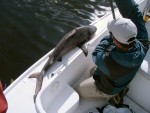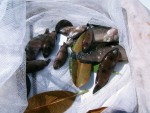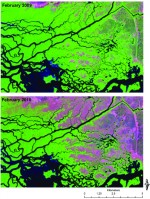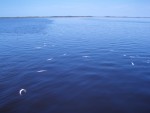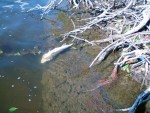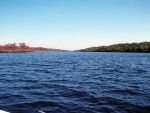ENSO (El Niño) events tend to produce cooler and wetter winter conditions in the southeastern United States. Warm-phase ENSO events also produce a strong subtropical jet stream, which in January 2010 resulted in frigid temperatures reaching South Florida, the Everglades, and our Florida Coastal Everglades (FCE) sites. The cause appeared to be a pronounced pattern of high pressure over the Arctic that allowed the cold air of the jet stream to be deflected further south than usual.
As a result, South Florida experienced extremely low temperatures, including a record low at Key West of 6 °C, the second lowest temperature since 1873. In Miami, air temperatures reached 2°C, but dipped as low as -2 °C in the Everglades. Temperatures this low were last recorded in the winters of 1989 and 1977. However, what was most notable about this cold snap was its duration. Air temperatures did not go above 11.5 °C for a record 12 days, the coldest period since 1940. Hydrological stations throughout Everglades National Park (ENP) recorded water temperatures as low as 5-6 °C in freshwater marshes and coastal habitats.
The effects of the cold snap appeared to be particularly strong in the estuarine and marine region of ENP. Mortality and defoliation strongly affected red mangroves (Fig.1), which have little capacity to resprout after freeze damage (Ross et al. 2009). Canopy structure, exposure, and proximity to the warmer marine environment appeared to influence the damage pattern. Tall forests near the coast were relatively unaffected, while at our SRS5 site several miles upriver, mangrove mortality was extensive on the west side of the Shark River (Fig. 2), perhaps a result of cold westerly winds (Gilmore et al. 1978).
Faunal mortality effects were severe on 28 species of native marine fishes, on endangered West Indian manatees, and threatened American crocodiles. Mortality was severe for important game species such as snook and tarpon, and for goliath grouper, a species of conservation concern (Fig 3a&b). Effects on bull sharks may have been high as well (Fig. 3d). Unlike the past 5 years when longlining proved effective at sampling bull sharks (Heithaus et al. 2009), sampling efforts so far have failed to yield a single capture.
Concern over the long term impacts of the cold snap on saltwater recreational fisheries is high. In 2006, 1 in 10 anglers fishing in the U.S. were fishing in Florida, the largest proportion of any state (USFWS 2006). Recreational fishing in ENP approaches 45,000 fishing trips per year, and 40 percent of anglers target snook (Osborne et al. 2006).
Among the positive effects of the cold snap was the extensive mortality of nonnative fishes and Burmese pythons. Lethal limits were reached for 14 of the 16 nonnative fishes established in ENP. In the vicinity of our SRS3 site, over 93 percent of fish mortality was nonnative (Fig. 3d).
Our understanding of how these rare cold snaps affect ecosystem structure and function is limited. Of particular interest is how the effects of cold mortality will interact with other stressors to affect ecosystem health, resilience, and its ability to provide for key services (e.g., fisheries). We expect that our long-term research efforts will provide important insights into ecosystem responses to this particular type of pulsed effect.
References
Gilmore, R.G., L.H. Bullock and F.H. Berry. 1978. Hypothermal mortality in marine fishes of South-Central Florida January, 1977. Northeast Gulf Science. 2:77-97.
Heithaus, M.R., B.K. Delius, A.J. Wirsing, and M. Dunphy-Daly. 2009. Physical factors influencing the distribution of a top predator in a subtropical estuary. Limnology & Oceanography 54: 472-482.
Osborne, J., T.W. Schmidt, and J. Kalafarski, 2006. Annual Marine Fisheries Report for Everglades National Park, 2005. South Florida Natural Resources Center, Homestead, FL.
Ross, M. S., P. L. Ruiz, J. P. Sah, and E. J. Hanan. 2009. Chilling events in a changing climate in coastal landscape of the subtropical zone: a case study from south Florida. Global Change Biology 15: 1817–1832.
U.S. Fish and Wildlife Service. 2006. National Survey of Fishing, Hunting and Wildlife Associated Recreation. Washington, DC: U.S. Fish and Wildlife Service.

 Enlarge this image
Enlarge this image